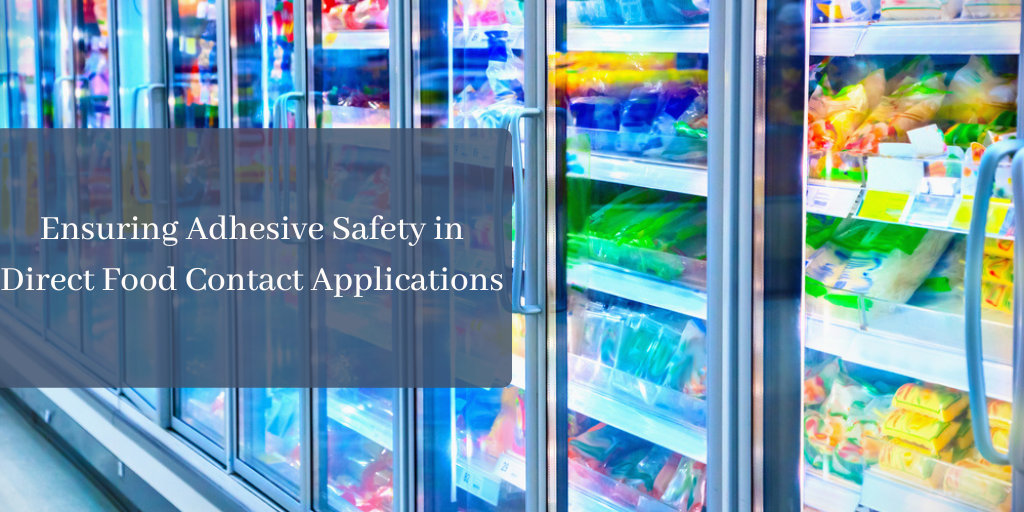When it comes to packaging the food we eat, safety extends well beyond just the ingredients and the primary packaging materials. One critical yet often overlooked component is the adhesive, particularly in direct food contact applications. These adhesives must meet strict regulatory standards and be applied under carefully controlled conditions to ensure they are safe for consumers.
As discussed in our previous blog, What Exactly is a Food-Safe Adhesive?, the FDA regulates materials used in food packaging to prevent contamination and protect public health. Adhesives are no exception.
In this post, we’ll explore the key regulatory requirements, best practices, and considerations for choosing food-grade adhesives that ensure safety and FDA compliance in packaging.
Understanding Direct Food Contact & Adhesive Regulations
Direct food contact occurs when an adhesive is in physical contact with a food product, such as labels on produce, inner linings of containers, or specialty food wraps. In these cases, the adhesive formulation and application must comply with food-safe glue regulations set by the FDA.
The primary regulation governing this is 21 CFR Part 175.105, which outlines permissible adhesive components and their conditions of use. Even FDA-approved adhesives must be applied according to Good Manufacturing Practices (GMPs) to minimize the risk of chemical migration into food.
Compliance isn’t just about the proper formulation—it’s also about correct application and ongoing quality control.
7 Key Considerations for Direct Food Contact Adhesive Safety
To ensure safety and regulatory compliance, manufacturers must approach adhesive safety for food packaging with precision and care:
1. Choose an Adhesive Approved for Direct Food Contact
Not all adhesives labeled “food-safe” are intended for direct contact. Work with your supplier to select adhesives specifically formulated and tested for these applications—like select hot melt adhesives (e.g., metallocene) or pressure-sensitive adhesives. Always request FDA compliance documentation.
2. Understand Usage Limitations
Refer to 21 CFR Part 175.105 to determine allowable uses based on the type of food. For example:
- Dry foods: Adhesives may contact food within GMP limits.
- Moist or fatty foods: Adhesive contact must be limited to trace areas such as seams or edges.
3. Control Adhesive Application
Use calibrated equipment and precise application methods to minimize overuse. Even approved adhesives can become unsafe if overapplied. Routine maintenance and operator training are essential.
4. Consider Barrier Layers
Whenever feasible, incorporate a functional barrier layer between the adhesive and food. Even a thin food-grade film can provide an extra level of protection.
5. Maintain Transparent Supplier Communication
Establish a direct line with your adhesive provider. Ask for complete compliance details, recommended usage guidelines, and ongoing support. Keep all documentation organized and accessible.
6. Implement Quality Control Checks
Regularly audit your adhesive use and packaging lines to verify GMP compliance and consistency. Early detection of application issues prevents downstream safety risks.
7. Stay Current on Regulatory Changes
FDA standards and interpretations evolve. Monitoring updates ensures your processes remain compliant and proactive.
Best Practices to Ensure Food-Safe Adhesive Use
Beyond regulations, adopting internal best practices further strengthens your safety strategy:
- Conduct Risk Assessments: Identify all points where adhesives could come into direct food contact.
- Train Your Team: Educate staff on proper adhesive application and the importance of using food-safe materials.
- Test for Compatibility: Even compliant adhesives must work effectively with other packaging materials to prevent delamination or chemical reactions.
- Consider Migration Testing: For complex or novel applications, migration testing ensures no harmful transfer occurs.
- Ensure Documentation & Traceability: Track adhesive types, batch numbers, and compliance certifications for full transparency.
Why Partnering with an Adhesive Expert Matters
Navigating FDA compliance in packaging can be complex, especially with the added responsibility of direct food contact. That’s why working with an experienced adhesive partner like LD Davis is essential. We provide:







